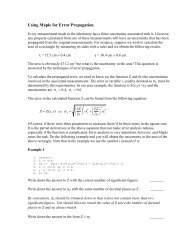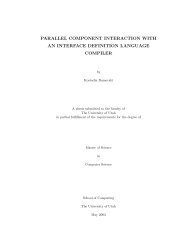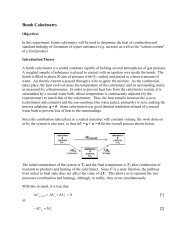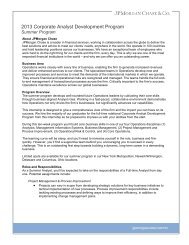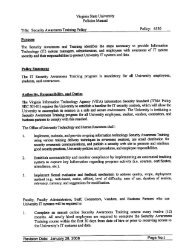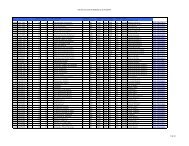Math 400 - 01 SPRING 2000 Solution for Test #3 1. (a) Definition: A ...
Math 400 - 01 SPRING 2000 Solution for Test #3 1. (a) Definition: A ...
Math 400 - 01 SPRING 2000 Solution for Test #3 1. (a) Definition: A ...
- No tags were found...
Create successful ePaper yourself
Turn your PDF publications into a flip-book with our unique Google optimized e-Paper software.
<strong>Math</strong> <strong>400</strong> - <strong>01</strong><strong>SPRING</strong> <strong>2000</strong><strong>Solution</strong> <strong>for</strong> <strong>Test</strong> <strong>#3</strong><strong>1.</strong> (a) <strong>Definition</strong>: A sequenceÆa K n n=1 is said to converge to a real number A (or has limit A , if <strong>for</strong>every P > 0, there is a positive integer N such thatKSymbolically,Æa n n=1(b) Given P > 0, if n ‡ N, then2n + 15n + 3 ? 2 5=Now, choose N >25P 12n + 15n + 3 ? 2 =5n ‡ N |a n ? A| < P.A Ø - P > 0, 0 N 5 J such thatn ‡ N |a n ? A| < P.10n + 5 ? 10n ? 625n + 15so that <strong>for</strong> n ‡ N, we have10n + 5 ? 10n ? 625n + 15= 125n + 15 † 125n † 125N= 125n + 15 † 125n † 125N < P(Why?)KHence, by the definition given in part (a), the sequence 2n + 1 converges to 2 .5n + 3 n=15(c) For P = 0.<strong>01</strong>, using part (b), we get N > 125 0.<strong>01</strong>value of N ‡ 5.= 4. So, <strong>for</strong> a choice of P = 0.<strong>01</strong>, the(d) A sequenceÆa K n n=1 does not converge to a real number A, if there exists P > 0, such that <strong>for</strong>all positive integer N there exists an n ‡ N with |a n ? A| ‡ P.KSymbolically,Æa n n=1 ` A Ø 0 P > 0,such that - N 5 J, 0 n ‡ N with |a n ? A| ‡ P.(e) Æa nKn=1 = Æn n=1 and Æb nKn=1 = Æ1 ? n n=1 are both divergent sequences. (Can you seewhy?) But, the sum of these two sequence,Æa n + b nKn=1 = Æ1 n=1 is a constant sequencethat converges to <strong>1.</strong>|x ? y|2. (a) Let x and y be two distinct real numbers. Set P = (i.e., |x ? y| = 2P . Then the2neighborhoods P = x ? P,x + P and S = y ? P,y + P are two disjoint neighborhoodsof x and y, respectively.Proof: Clearly, P and S are neighborhoods of x and y, respectively. We want to show thatP V S = 2, that is P and S have no point in common. Suppose P V S fi 2. That is,suppose that P and S have a common point, say z. ThenBut then|x ? z| < P and |y ? z < P2P = |x ? y| = |x ? z + z ? y| † |x ? z| + |z ? y| < P + P = 2P.A contradiction! Hence, there is no such a common point z, that is P V S = 21
(b) We may choose P = 1 2 . (In fact, any positive real number less than or equal to 1 2 works.)Then52 ? P, 5 2Thus, 2,4 is a neighborhood of 5 2 .3. (a) <strong>Definition</strong>: A sequenceÆa K n n=1exists an N 5 J such that(b) Given P > 0, if n ‡ N, then|a n ? a m | = 3n2n + 1 ?+ P = 2,3 — 2,4 .is said to be a Cauchy sequence, if <strong>for</strong> every P > 0, theren,m ‡ N |a n ? a m | < P.3m2m + 1= 6nm + 3n ? 6nm ? 3m2n + 1 2m + 13|n ? m|=4nm + 2n + 2m + 13|n ? m|†4nm†4n3†4N3Now, choose N ‡4P 3 , so that if n,m ‡ N, then|a n ? a m | = 3n2n + 1 ? 3m2m + 1Hence, the sequenceK3n2n + 1 n=1is Cauchy.† 3 4n † 34N < P.(Why?)(Why?)(c) LetÆa n K n=1 and Æb n K n=1 be Cauchy sequences. We want to show thatÆa n + b n Kn=1 is Cauchy.Let P > 0. SinceÆa n K n=1 and Æb n K n=1 are Cauchy sequences, there exist positive integers N 1and N 2 such thatn,m ‡ N 1 |a n ? a m |
5. (a) In class, we have proved that m‚Klim 1 + m1 m= e. Now if we let m = 3n, then n = m and 3more over, as n tends to K, so does m. Thus,limn‚K 1 + 1 3nThus, the sequencen= limm‚K1 + 1 m1 + 1 3nnm/3= limm‚K1 + 1 m= e 1/3 .Kconverges to e 1/3 .(b) In class, we have proved that lim n‚Kr n = 0, if |r| < <strong>1.</strong>(c) lim n‚Kn ? n 2 + nThus, lim e nn‚K ^nn=1= lim n‚Ke^ n = 0 since e^ < <strong>1.</strong>= lim n‚Kn ? n 2 + nn= lim2 ? n 2 + nn‚Kn + n 2 + n= lim ?nn‚Kn + n 2 + nn + n 2 + nn + n 2 + nm 1 3= ?1 (Why?)(Why?)6. (i) False. A finite set has no accumulation point. Every point of a finite set is an isolated point ofthe set.(ii) False. Not every infinite set has an accumulation point. For instance, the set of integers has noaccumulation point. (Can you give another infinite set that has no accumulation point?)(iii) False. ?1 n n + n Kis a bounded sequence that is not convergent.1 n=1(iv) False. For r > 1, the sequenceÆr n K n=1 diverges. For instanceÆ3 n K n=1 diverges to K.(v) False. The sequenceÆ ?1 n n=1Kis bounded but not Cauchy. (Why?)K(vi) False. The sequenceÆ|cos n^ | n=1 = Æ| ?1 n K| n=1 = Æ1 n=1 is convergent while Æ ?1 n Kn=1is not.3



